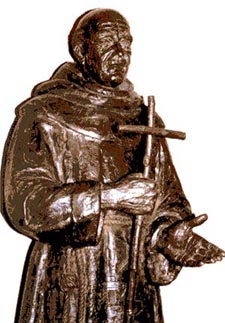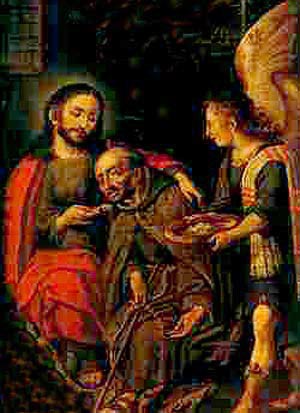 |
The Saint of the Day
St. Peter of Alcântara, October 19
Prof. Plinio Corrêa de Oliveira
Biographical selection:
“Blessed be the penances which earned me such glory!”

St. Peter of Alcântara
|
These were the words of St. Peter of Alcântara when, after his death, he appeared to St. Teresa of Avila telling her what had been reserved for him in Heaven.
She recounted those penances that the Saint himself had described to her when he was alive. For a period of 40 years he slept for only one and a half hours each day. To keep sleep from overcoming him, he used to remain standing or kneeling. When he permitted himself to sleep, he did so seated on a bench with his head resting on a block of wood fixed on the wall. He always went barefoot.
His only clothing was his habit and a cape, and often in the winter he would take off his cape and keep the door and windows open to suffer the cold. He would eat only every three days. His poverty was extreme.
“He was already very old when I met him for the first time,” said St. Teresa. She continued: “He was thin and his skin seemed more like the bark of a withered tree. He used to speak only when he was addressed. He had very good sense, and his conversation was amiable and pleasant.”
Comments of Prof. Plinio:
The figure of this Saint terrifies the new generations. I think that a few words are necessary to explain him.
First, his life proves that man can support much more suffering than one thinks. There are many people who came through the concentration camps in World War II and were reduced to skeletons. Afterward they became healthy and fat again, and still today many are alive and active everywhere in Europe.
Second, one can see how mankind is deteriorating today, and can no longer support the same penances that St. Peter of Alcântara in the 16th century willingly took on himself. It seems that the ensemble of mankind is losing its strength, following the general degradation of the universe. The biological make-up, the biological fullness of man is becoming less than what it used to be.
Third, one has to understand that besides the great human strength that permitted men of times past to suffer the way St. Peter of Alcântara did, there was also the role of grace. Many of things he did, he could not have done without a special grace, perhaps even a miracle, helping him. Without these graces he could not have led such a rigorous lifestyle.

Ecstasy of St. Peter of Alcantara - Melchior Perez Holguin, 18th century, National Museum of Art, Bolivia
|
Fourth, one can ask why such severe penances as those taken on by St. Peter of Alcantara existed in the Catholic Church. There are reasons for that. Since man was able to support them, it offered a great glory for God that His sons and daughters would voluntarily suffer those penances for love of Him. Also it was indispensable that we have a record of such extraordinary penances so that we might understand how good and merciful God is when He does not ask us to do the same. He accommodates Himself to our weakness and misery. This is a reason to make us more grateful to Him.
Fifth, there is a touching contrast between the grandiose way of sanctity of St. Peter of Alcantara and the little way of St. Therese of the Child Jesus. She carried out the normal penances of a Carmelite nun, which were far from being the terrifying penances of St. Peter of Alcântara. Nonetheless, to die with tuberculosis at age 24 as she did implies a great deal of suffering. To have such an illness that corrodes the human organism in a certain sense is more trying than his great mortifications. But it was a different kind of suffering, a suffering of the little way, a suffering accessible to all, and not those tremendous self-imposed exercises of St. Peter of Alcantara, such as his decision to endure the winter cold in Spain. Many of you have no idea how strong and intense a cold wind in Spain is. He was pleased to suffer it for the love of God.
Sixth, someone could ask me: Are those penances of St. Peter of Alcantâra something we should do? Certainly today we aren’t call to make those grand physical penances. There is a form of suffering to which all of us are called, a kind of suffering that both St. Peter of Alcântara and St. Therese of the Child Jesus had to bear intensely. It is to endure sufferings of the spirit. It is to carry great spiritual crosses and endure the great sufferings of soul that accompany our apostolate.
I am sure that St. Peter of Alcântara, seeing the situation of the Franciscan Order at his time, suffered a lot. Such suffering was a strong stimulus for him to reform the Order, which he did. St. Therese of the Child Jesus also suffered greatly from living in a Convent where almost no one, including her superior, understood her. This represented a great cross. Also she voluntarily chose to offer herself in holocaust for love of God, which is indisputably a tremendous suffering.
All of us can relate in some way to this kind of suffering, especially if one takes seriously the great crisis that afflicts the ensemble of the Catholic Church. Such sufferings often appear on our pathways. We should support them with patience and joy because to be a Catholic is to be one who suffers. The Catholic who does not suffer is unworthy, his life futile. He does not follow the same path of Our Lord Jesus Christ, which is the path of the cross.
These are some considerations that I offer you admiring the penances of the great St. Peter of Alcântara. Let us ask him to help us to support the spiritual sufferings we are called to bear in as worthy and holy a way as he did with his grandiose physical and moral penances.


  | | Prof. Plinio Corrêa de Oliveira | |
The Saint of the Day features highlights from the lives of saints based on comments made by the late Prof. Plinio Corrêa de Oliveira. Following the example of St. John Bosco who used to make similar talks for the boys of his College, each evening it was Prof. Plinio’s custom to make a short commentary on the lives of the next day’s saint in a meeting for youth in order to encourage them in the practice of virtue and love for the Catholic Church. TIA thought that its readers could profit from these valuable commentaries.
The texts of both the biographical data and the comments come from personal notes taken by Atila S. Guimarães from 1964 to 1995. Given the fact that the source is a personal notebook, it is possible that at times the biographic notes transcribed here will not rigorously follow the original text read by Prof. Plinio. The commentaries have also been adapted and translated for TIA’s site.
|
Saint of the Day | Home | Books | CDs | Search | Contact Us | Donate

© 2002- Tradition in Action, Inc. All Rights Reserved
|
 |

|